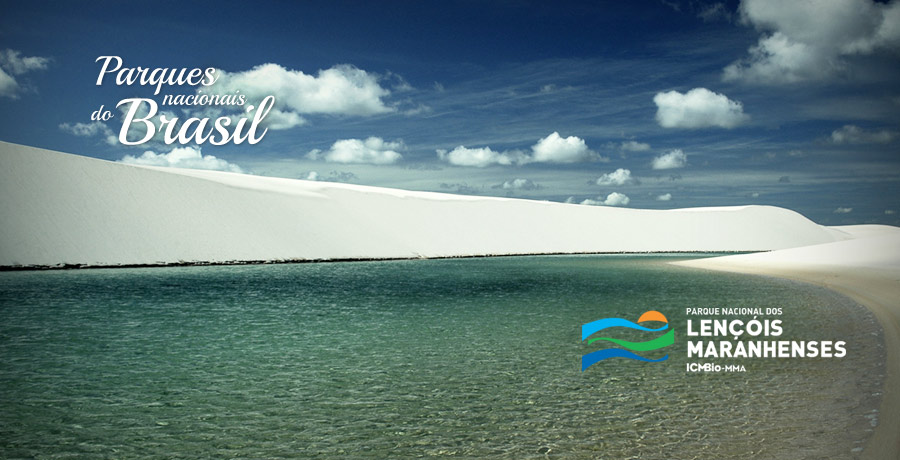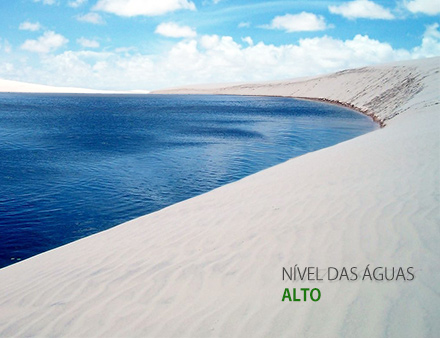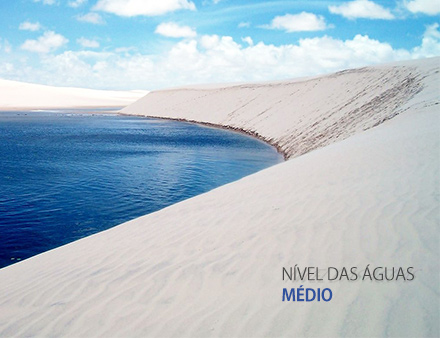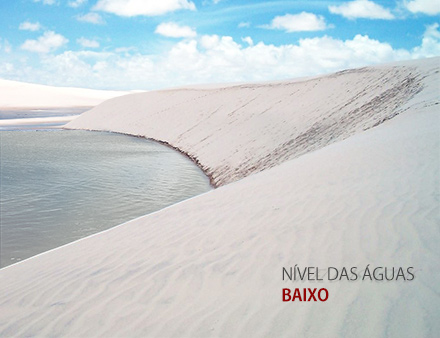

.
Visitant Guide
The Lençóis Maranhenses National Park is the perfect destination for those in search of adventure and nature contemplation.
Walk on the white sand dunes on the biggest dune field in Brazil, cool off at the numerous crystal-clear lagoons and watch the sunset are unique experiences that you will bring for the rest of your life. Adding this to the emotion of an off-road ride in accredited 4x4 vehicles specially adapted to go through the sandy and flooded terrain of the Lençóis Maranhenses restinga (coastal vegetation). For those that prefer long walks and interaction with traditional communities, there is the possibility to venture and cross the dune fields, as well as experience an overnight on the “Brazilian desert” oasis.
The Lençóis Maranhenses National Park, located on the oriental coast of the Maranhão state, is the prime tourism destination in this state. It is inserted on the Cerrado region and has a strong influence from the Caatinga and the Amazon regions, so you can find specimens that are common from these 3 biomes. In its 155 thousand ha, it shelters diverse and fragile ecosystems, as the restinga (coastal vegetation), the mangrove and a dune feld - which occupies 2/3 of the total area of the National Park - and that is the main attraction of this Park, due to the lagoons that form in between the dunes on the region’s rainy season. The Park’s inserted in 3 maranhenses municipalities, that possess the infrastructure for the reception and the conduction of visitors: Barreirinhas, Santo Amaro and Primeira Cruz.
WHEN SHOULD I GO?
The oriental coast of the Maranhão state goes through two characteristic seasons throughout the year. The rainy season, that goes from February to May, and the dry season, from June to January. After the rainy season the Lençóis Maranhenses National Park is on its peak of beauty, since the lagoons that form in between the dunes are full.
With the advance of the dry season, the lagoons dry piece by piece, reaching its driest peak in November. It is important to make clear that these conditions depend on the rain regiment of the year, so it’s always important to search for information with the National Park administration or with the local reception.
The best time of the year to visit the Lençóis Maranhenses National Park is between May and September, but the unity is opened for visitation year around, Monday to Monday, from 8 a.m to 6 p.m.
- High water level:

After the rainy season on the oriental coast of Maranhão, that can have up to 4 months of intense rains, the lagoons and rivers from the Lençóis Maranhenses National Park are with the highest water level, providing to the visitants the opportunity to see the symbol image of the Lençóis Maranhenses: multicolor lagoons surrounded by white sand dunes.
Recommended activities:
- Water recreation, like swimming;
- Lagoons and dunes contemplation;
- Walks.
Period: from May to August.
- Medium water level:

As the dry season arrives, the lagoons start to dry up due to solar and wind action. In this part of the year, the lagoons are not as full as they were, but still enables the opportunity of water recreation, although limited. The landscape from the Lençóis Maranhenses National Park starts to change, the lagoons start to shrink in size and depth and there is a surge of algae and water vegetation.
In the start of the rainy season the lagoons maintain a medium water level as they fill, but in this season, there is heavy rain almost daily.
Recommended activities:
- Limited water recreation;
- Lagoons and dunes contemplation;
- Walks.
Period: from September to October / from February to April.
- Low water level:

In the peak of the “summer”, as the dry season is called in the region and goes from June to January, - which has nothing to do with the astronomical seasons – the temporary lagoons and rivers are dry or with a low water level. The lagoons give space to pastures and meadows, which forms on top of the humid soil that was the lagoon floor. In this period the water recreation is only possible on permanent lagoons, as the Lagoa do Peixe (Fish Lagoon) and the Lagoa da Esperança (Hope Lagoon).
Recommended activities:
- Water recreation on permanent lagoons;
- Dunes contemplation;
- Walks.
Period: from November to January.
HOW CAN I GET THERE?
The closest commercial airports are in São Luiz/MA (code SLZ) and in Parnaíba/PI (code PHB).
The main cities that give access to the Lençóis Maranhenses National Park are Barreirinhas and Santo Amaro do Maranhão, but there is also access from Humberto de Campos and Primeira Cruz.
Barreirinhas: The main access is from the MA-402 highway, paved and with good traffic conditions. The city has logging infrastructure and alimentation, as well as numerous tourist agencies that provide tours to the National Park and other attractions, as speedboats tours to the mouth of the Preguiças River and the float-cross at the Formiga River.
For those that are looking for adventure, another access rout is via Paulino Neves/MA. This stretch is part of the Emotion Rout, a tourist itinerary that initiates in Ceará state, crosses the coast from the state of Piaui and ends in Maranhão. In this itinerary it’s possible to visit 3 federal conservation units: the Jericoacoara National Park, the Ambiental Protection Area of the Delta of the Parnaíba and the Lençóis Maranhenses National Park.
The access to the Lençóis Maranhenses National Park through Barreirinhas starts with the crossing of the Preguiças River by ferry. From this point on, only vehicles with 4x4 traction equipped with snorkel can move on.
Santo Amaro: In order to get to Santo Amaro, it is necessary to use the MA-402 highway. The city has hostels and restaurants, and its only 2 km from the Lençóis Marnhenses National Park, that can be reached by foot or by traditional vehicles.
TICKETS
Currently there is no ticket fees from ICMBio (Chico Mendes Institute for Conservation and Biodiversity, in English). The Park accredited agencies and tourism operators charge fees for their services.
Here and here is a list with accredited guides from the Lençóis Maranhenses National Park.
For more information, you can reach us by phone on the + 55 98 3349-1267 or by e-mail, on O endereço de e-mail address está sendo protegido de spambots. Você precisa ativar o JavaScript enabled para vê-lo.
ATTRACTIONS

In Barreirinhas:
- Lagoa Azul Circuit (Blue Lagoon Circuit) – It is one of the most visited attraction at the Conservation Unit. After 12 Km of trails at the restinga (coastal vegetation), the ride goes through the dune fields at an approximately 02 Km trail. Throughout the rout, the visitor may visit the Lagoa da Preguiça (Sloth Lagoon), the Lagoa da Esmeralda (Emerald Lagoon), the Lagoa Azul (Blue Lagoon) and the Lagoa do Peixe (Fish Lagoon) – which is the sole perennial lagoon, and that stay with water year around. This attraction is the only one with permission to access with traditional vehicles until the limits of the Lagoa da Preguiça, but only for visitors with locomotion difficulty and through communication and obtaining authorization with the administration of the National Park.
- Lagoa Bonita Circuit (Beautiful Lagoon Circuit) – Located 15 Km away from Barreirinhas, the attraction is considered as a medium access difficulty attraction, because it is necessary to climb a steep dune that it’s approximately 30 meters high; there is, however, a rope to help with the climb. The effort is compensated with a beautiful view from the dune field and from the National Park’s restinga vegetation. After the climb, the visitor will walk some hundred feet to the Lagoa Bonita. At this circuit it is also possible to visit the Lagoa do Clone (Clone Lagoon) – the lagoon receives this name because of the taping of a famous soap opera from the Rede Globo called “O Clone”, from 2001.
- Lagoa da Esperança (Hope Lagoon) – It is formed from the interruption of the course of the Negro River, caused by the meeting from the river with the dune fields. Because of this fact, this lagoon is perennial, and it’s not situated inside the dune fields, but at the margin of it, making possible to go through the dune fields as well. As it is perennial, the lagoon is ideal to be visited at the dry months, when the other lagoons are dry. The Lagoa da Esperança makes border with the municipalities of Barreirinhas and Santo Amaro.
- Atins – The village of Atins is located on the mouth of the Preguiças river, outside the National Park, but is close, so strolls at the beach, at the restinga, dunes and fields, are easily made. The village has simple infrastructure, and it’s searched by visitors that are looking for peace and quiet, as well as an intimate contact with nature and the local community. At Atins it’s possible to practice sports, such as kite-surf, wind-surf, kayaking, stand up paddle, bicycle ride, surf and others.
- Canto dos Lençóis (Lençóis Quarter) – Located inside the National Park, the Lençóis quarter, formerly called as Atins Quarter, is a small village formed by traditional fishermen. From there, you can have a nice view from the dune fields, and it is next to the beach. The village has no electric energy but there are community restaurants that serve typical food and offer simple accommodation. It is a great starting point for a trekking and for the crossing of the dune fields until the municipality of Santo Amaro.
- Circuito Foz do Rio Negro (Negro River Mouth Circuit) – The script from the Negro River is made through the beach from the National Park, starting at Atins. The place where the Negro River meets the Sea is the main attraction, where the visitor may bath on the small waterfalls on the shore. This attraction is available only when the Negro River has water, so inform yourself with the administration or with the local reception previously. It is also possible to visit, within the circuit, some lagoons like the Lagoa Verde (Green Lagoon), that is close to the beach and it’s within a 30 minutes’ walk from the dune fields and stays with water for most part of the year.
In Santo Amaro
- Lagoa da Gaivota (Seagull Lagoon) – It is the main attraction on the municipality and it is considered the most beautiful landscape from the Lençóis Maranhense National Park. The Lagoa da Gaivota is located at a seagull nidification area, so it is possible to practice birdwatching. Other parts of the circuits are the Lagoas da Andorinha (Swallow Lagoons), the Lagoa do Cajueiro (Cashew tree Lagoon) and the Lagoa do Maçarico (Solitary Sandpiper Lagoon), which is proper for kitesurf practice. On the path to the attraction it’s possible to see the Lago de Santo Amaro (Santo Amaro Lake). The access can be made by walking trails or by 4x4 park-accredited vehicles.
- Lagoa da Betânia (Betânia Lagoon) – As the Esperança Lagoon, it’s a river course interrupted by the dune field. The attraction is located at the village of Betânia that offers some basic services. The variation of the color of the water and the landscape with the dune fields as background makes the visit to this attraction unique.
- Lagoa das Emendadas (Emendadas Lagoon) – Accessible only by waking, there’s several lagoons in between dunes – inside the dune fields – that are connected and can extend up to a couple of kilometers. As it is an attraction inside the dune fields, the visitor can have a notion of the size of the Lençóis Maranhense.
- Praia da Travosa (Travosa Beach) – Located next to the village of Travosa, a fishing community, the Praia da Travosa offers a great shore extension and has the dune field as background. There is a regional surf championship in April.
Primitive Zone:
- Queimada dos Britos and Baixa Grande – Located inside the dune field from the Lençóis Maranhenses National Park, these two restinga vegetation zones are true oasis and a perfect spot for an overnight for those that want to make the park crossing. According to the zoning of the National Park, these regions are the Primitive Zone, where visitation can only occur with minimum impact. Therefore, it is prohibited to use any kind of motorized vehicles for tours or visits. Despite that, some 30 families live in the location, so them – and only them – can use motorizes vehicles for safeguards for life and for transportation of people, food and materials.
It is, without a doubt, the best attraction of the unit! The hiking, that may take up to 5 days, are made through the beach and the dunes, with refreshing baths at the lagoons. The overnights are done at the communities, which is a great experience to interact with the traditional population.
The oasis are filled with the biggest biodiversity of flora and fauna at the National Park, and they have lagoons where you can bathe during most of the year, either inside the oasis or inside the dune field.
It is mandatory to hire a visitant conductor, as you are entering in the primitive zone. It is easy to get lost at the dune fields, in most of the path there is no cellular coverage and some places may spend days without movement of people. You are responsible for your safety, do not try to cross the National Park if you are not sure that you have physical conditions to do it safely.
WHAT TO DO
- Hiking;
- Fauna Watching;
- Picknick at the permitted areas;
- Pond baths;
- Water sports;
- Bicycle rides;
- Off-road driving.
ORIENTATIONS
The ICMBio Decree number 199/2017 and the Management Plan of the Lençóis Maranhences National Park govern the main visitation rules. These rules are necessary to ensure the safety of the visitants and of the protected environments; therefore, always follow the orientation of the visitor’s conductors and the signs. Here below we list of the main set of information for those who want to visit the National Park:
- Transportation and visitant’s conduction may be done by accredited vehicles, drivers and visitant’s conductors. To avoid any problems, be sure that your vehicle has the National Park logo sticker with the credential number and if the drivers have identification badge;
- Transportation and tours in private cars are not permitted;
- The sale, possession and consumption of alcoholic beverages and illicit drugs is prohibited in the National Park;
- Transit of motorized vehicles over the dune field is prohibited;
- It is prohibited to light any kind of fire, even campfires, barbecues and stoves;
- The entrance of domesticated animals is prohibited;
- It is prohibited to enter the National Park in quadricycles, motorcycles, buggies, as well as practice endures and/or rallies.
Infractions to those rules will subject the visitor and the service provider to fines, according to the Decree 6.514/08 and the Environmental Crime Law (9.605/98). Help the ICMBio protect this national heritage and promote the sustainable development in the region, be a conscious visitor!
SAFETY
Before starting your tour inside the Lençóis Maranhenses National Park, be aware of some fundamental issues to ensure your comfort, safety and make your visit experience even better!
- Remember to always bring mineral water with you or other hydrating agents to the tour, every accredited vehicle is obliged to provide iced coolers. Stay hydrated during the whole tour!
- The ride has medium length of 04 hours, therefore, bring a small and light snack, ideally dried fruits and sandwiches.
- The Lençóis Maranhenses region is located 02º south of the Equator, which means that there’s a high incidence of solar rays during the year. Apply sunscreen or protect yourself from the sun with light clothing with light colors and hats or caps. Remember: the utilization of bronzers, bleaching cream, corporal oils and hygiene products on the lagoons and rivers from the National Park are prohibited, cooperate with the maintenance of the water quality from the lagoons!
- There are neither public toilets or foods and beverages selling points inside the National Park.
- For your own safety and from the protected environments, always follow the orientation from the visitant’s conductors and the signs of the National Park.
 Translated by volunteers Matheus Meyer and Sérgio Oliveira
Translated by volunteers Matheus Meyer and Sérgio Oliveira









